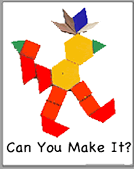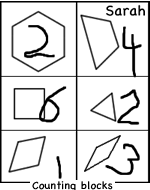Teach children to recognize, create, copy and extend patterns using games and activities.
Preschool and kindergarten pattern activities can be taught in short five-minute segments and with games such as “Copycat” and “What’s Hiding?”.
Use the correct pattern block names as the children are involved in activities and games and they will soon start using pattern block vocabulary.
Give children lots of time to play with pattern blocks in an unstructured way before using them for specific activities.
Pattern Blocks
Pattern blocks are a wonderful math resource for the classroom. They come in 6 colors and shapes, yellow hexagons, green triangles, blue diamond-shaped rhombus, red trapezoid, orange squares and a smaller beige rhombus.
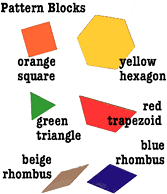
Using pattern blocks when teaching math, not only develops math vocabulary but also helps children understand many other math concepts such as symmetry, order, counting, number operations, data collection, and estimation.
Fun Ideas for 5 minute repeating pattern activities
Note. The term pattern has a variety of meanings depending on vocations. For the purpose of kindergarten math, the term often refers to repeating patterns such as red, blue, red, blue, red, blue, etc.
- clap patterns – fast, fast, slow, fast, fast, slow
- actions – hop, hop, clap, clap, hop, hop, clap, clap
- drama activities – swirl arms like the wind, arms out like the sunshine as you say windy, windy, sunshine; windy, windy, sunshine
- line up at the door in patterns – boy, girl, boy, girl
- create color patterns with materials – red crayon, blue crayon, red crayon, blue crayon
- put pattern blocks in the pocket chart and read, hexagon, hexagon, triangle, hexagon, hexagon, triangle…
- diagrams – e.g. draw big apple, big apple, small apple; repeat
- letters and words – put letters or words in the pocket chart and read them. AA BB, AA BB or cat, cat, dog; cat, cat, dog
- link to poetry e.g. Jack be Nimble – act out or draw on chalkboard, tall candle, short candle, short candle, tall candle, short candle…
Teach pattern games
1. Can you make it?
Purpose – to teach pattern block vocabulary (not a repeating pattern activity)
Materials:
- Lots of pattern blocks
- A work surface for each child (plastic mats, piece of cardboard; blank are best as there is less to distract the children).
How to play:
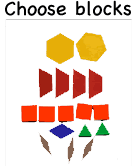
- Teacher demonstrates and says slowly – e.g. “Choose 2 hexagons, 4 trapezoid, 2 triangles, 5 squares, 1 blue rhombus, 3 beige rhombus (begin with just a few shapes). Put them on your mat.”
- Then, “I’m thinking of a bird. Can you make it?”
- Children make a bird using only the patterns blocks chosen above.
- Then different students can take turns saying what pattern blocks to choose and what to make.
Record
Extend the kindergarten pattern activities to the connecting level.
Ask the children to count and record how many of each block they used to make the bird, then how many blocks did they use all together. See image below. Children reflect on their experiences as they record their thinking.
2. Copycat
Purpose: To give children practise making and recognizing repeating patterns
Materials:
- Thin strip of lightweight card about 15 inches long and 3 inches wide for each two students.
- Pattern blocks for each child.
How to play:
- Demonstrate first.
- This activity starts with one child making a repeating pattern until half the strip of card is covered, then the second child finishes it.
- Children trade places and the other takes a turn creating the repeat pattern and the first child finishes it.
3. What’s Hiding
Purpose: To give children practise making and recognizing repeating patterns
Materials:
- A thin strip of lightweight card about 15 inches long and 3 inches wide for each 2 children
- Pattern blocks for each two children
- A piece of card about the size of a playing card for each two children
How to play:
- Demonstrate first.
- One child creates a repeating pattern on the strip of card and covers a small portion of it by holding a playing card over it.
- The other child looks at the repeating pattern that is showing and then tries to guess what pattern blocks are “hiding” under the card.
- Note: Educators will have to check that the child making the pattern is actually creating a pattern and not a random row of blocks!
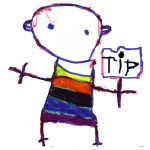
Tips for Playing Math Games
1. When I started teaching, I would constantly lose track of which children had a turn and which ones hadn’t when we were playing games. Then I discovered this easy way to keep track.
Keep a stack of small cards with the children’s name printed on them and held together with an elastic band. Put them in your pocket or close by.
Throughout the day, as you play games or do an activity where the children get to have turns doing something in a game, choose a name from the top of the pile, then place it on the bottom. Start at the next name when another game is played or on the following day. This ends the, “It’s not fair. I never get a turn,” problem and also frees you from trying to keep track!
2. Call any math activity a “game” and you have the children’s attention.
3. Always give the children 5 minutes to explore the materials and create something of their own with the game materials, quickly have a look around the circle to appreciate what everyone has made, then start the actual game.
4. Demonstrate games one time. Then demonstrate again slowly as the children follow along.
5. Keep games open-ended so that all children are able to practice skills. If one child can only master counting to five, let him/her work with five blocks while another child works with seven.
6. Try wooden magnetic pattern blocks for the child with less developed fine motor skills. They are heavier and do not move around as easily.
7. Use squares of felt under pattern blocks if they are on a hard surface like a table. This keeps them from shifting easily and frustrating the children.
